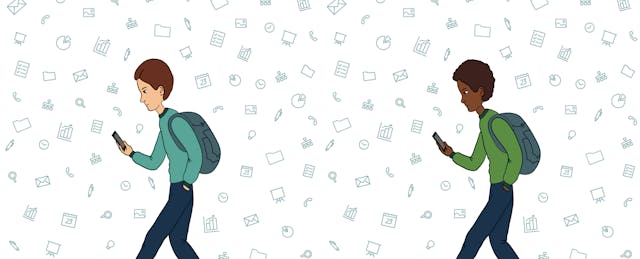What do Dave Chapelle shows and a growing number of schools have in common?
You can’t use your cell phone in either place.
A growing number of entertainers, including Chapelle and musicians Jack White and John Mayer, prohibit the use of mobile devices during their performances. They want people to enjoy the moment, not just capture it. Many worry about how widely their original materials are shared online.
In a similar vein, educators say they want students to pay attention in class, something they can’t do if they’re fixated on Instagram, Fortnite or the app du jour. “Some of them have no idea how many times they check their phones,” says Yvonne Shiu, the principal of San Mateo High School in California. “For them, the device has become like an extra appendage.”
Performing artists and educators alike have been turning to a low-tech, no-frills method to keep devices out of sight and out of mind. Developed by Yondr, it’s a small, green pouch with a magnetic lock that can only be unlocked with a special device. The idea is mind-numbingly simple: People lock up their phones before school—or the show—starts, and can only unlock it afterward.
Founded in 2014, the San Francisco-based company says that it has leased pouches to more than 1,000 schools across the country, including a handful of colleges and universities. This month, San Mateo High School became the largest public school to deploy them for all 1,700 of its students. Each Yondr pouch costs $12 for a one-year lease, which puts the tab at over $20,000. The funding comes from the San Mateo High School Foundation, made up of the school’s alumni, parents and community donors.
Before the start of this school year, every parent and student had to sign a policy outlining the terms of the new cell phone ban, which forbids any use of the devices during the school day, even between classes.

For most adults, the idea of being separated from a smartphone for just one hour can stir anxiety. So it’s understandable that some students were unhappy about the new policy (to put it mildly). “Imagine the typical teenager’s response when you tell them they can’t do something,” says Isabelle Bushman, whose daughter attends the high school. The initial reaction, she recalls, went something like: “‘This sucks. Why are they taking away my rights and my phone?’”
Such a drastic measure was not taken without prior consultation, assures Shiu. Earlier this spring, the school piloted pouches with 13 teachers, who locked up students’ phones for the duration of their classes. Another 25 students volunteered to lock up their phones throughout the school day.
“Teachers reported that [the pouches] helped increase attention and engagement in class, since students weren’t constantly distracted by checking their phones,” says Shiu. In between classes, students who tried the pouches told her they had more—gasp—face-to-face conversations with their peers.
When school officials shared plans for the broader rollout of Yondr pouches, some parents expressed reservations. Most were centered on how they would contact their children in cases of school emergencies. Others asked how the school would communicate last-minute schedule changes for sports matches.
Those concerns are hardly surprising to Dr. Devorah Heitner, who researches the impact of digital device on children’s wellbeing and is the author of “Screenwise,” a book on the subject. “Parents today are very accustomed to being able to reach their kids—or anyone—at any time. Any time you interrupt that, that will cause a certain level of anxiety,” she says.
Shiu says her staff has made contingency plans to assuage parents’ concerns. And if students really do need to contact their parents during the school day, they can use the office phone. That’s already happened, says Shiu, who adds that she’s glad most of her students can still remember their parents’ numbers.
Without smartphones, students are also “using a little bit more brain power,” quips Shiu. “They used to take a picture of their class schedule on their phones to know where to go. Or they would take a picture of their locker combinations and never have to remember their code.”
Do Bans Work?
There are drawbacks to blanket bans on cell phones, which—believe it or not—can be used for productive, even educational purposes. Many students use popular apps like Quizlet for last-minute cramming before a test, for instance.
But some studies suggest there’s a correlation between cell phone bans and better learning outcomes. One study of high schools in England found that those that introduced a mobile phone ban saw an improvement in student performance on a year-end test. Another report, involving college students, associated frequent cell phone use with anxiety and lower grades.
“I’m in favor of cell phone bans in high schools, not just for their potential impact on academics and social interaction, but also for the mental health benefits to students,” says Paul Weigle, an advisory board member of Children and Screens, an interdisciplinary research organization.
Weigle, who is also a child and adolescent psychiatrist based in Connecticut, says he has “seen a pattern of young people whose obsessive social media use becomes impairing, where they’re checking their phones hundreds of times a day, so much that it becomes hard to concentrate on what they need to do to be successful socially and academically.” Even teenagers themselves say they spend too much time on cell phones, according to a recent Pew Research survey.

Other countries are banning mobile phones on a much grander scale. France set the bar last year with a new law that prohibits students under the age of 15 from using phones, tablets and smart watches in schools. Similarly, the state of Victoria in Australia is planning to ban the use of mobile phones in all primary and secondary schools next year.
But Heitner cautions school officials against going with cellphone bans as a first resort. School leaders ought to consider providing teachers with additional professional development around appropriate tech usage before considering more drastic measures, she says.
At San Mateo, the initial shock of the ban policy seems to have worn off. Bushman says her daughter has stopped complaining about it. And it’s made her more self-aware of her attachment to her cell phone as well.
“I look at it as a learning opportunity about a habit. I know myself—I look at my phone even when I don’t need or want to. I think it’s growing on people.”


